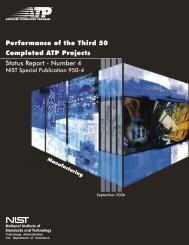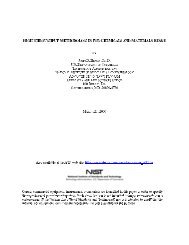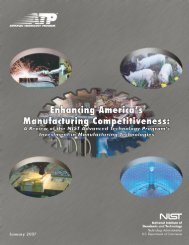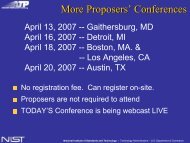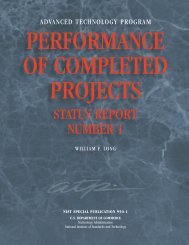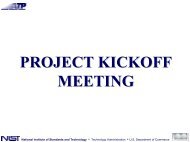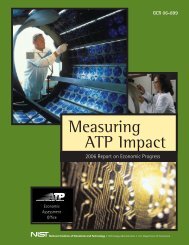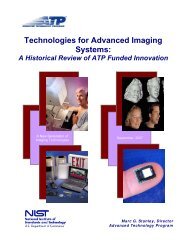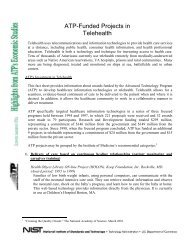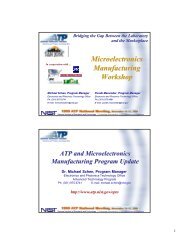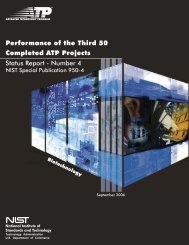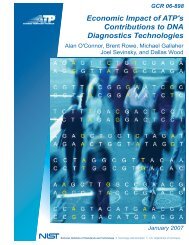Direct and Spillover Effects of ATP-Funded Photonics Technologies
Direct and Spillover Effects of ATP-Funded Photonics Technologies
Direct and Spillover Effects of ATP-Funded Photonics Technologies
- No tags were found...
You also want an ePaper? Increase the reach of your titles
YUMPU automatically turns print PDFs into web optimized ePapers that Google loves.
In summary, together with Uniax early investor <strong>and</strong> collaborator Neste/Panipol, patents fromTherm-O-Disc, IBM, Monsanto (plus the related citations attributed to Crosslink principals),<strong>and</strong> Eveready counted for more than half (56 <strong>of</strong> 110) <strong>of</strong> the total citations to Uniax patents.Nonetheless, as in the Displaytech case, our interviews again found little evidence amongthese main citing groups <strong>of</strong> significant economic value through the spillover <strong>of</strong> technicalinformation. In contrast with the Gemfire citations in the Displaytech case, these citingscientists were uniformly aware <strong>of</strong> the Uniax research, though in some cases not the details.As indicators, these patent citations were slightly more useful in tracking diffusion <strong>of</strong> Uniaxtechnology than for Displaytech. However the citations were not really indicators <strong>of</strong> strongidea flows, but rather acknowledgements <strong>of</strong> alternative approaches <strong>and</strong> prior art in thepatent literature. None <strong>of</strong> these top-citing organizations, except collaborating partnerNeste/Panipol, had directly used or were yet commercially pursuing Uniax-influencedtechnologies. Under licence from Uniax/DuPont, Neste’s spin<strong>of</strong>f company Panipol is sellingrelated polymer technologies. The economic value created from that licencing is directlywithin-market, <strong>and</strong> presumably was already accounted for above as part <strong>of</strong> the price DuPontpaid to acquire Uniax. Moreover, Neste was half owner <strong>of</strong> Uniax in the early to mid-1990speriod in which their Uniax citations occurred. A significant question arises here, then, <strong>of</strong>how to classify the boundaries <strong>of</strong> the firm in studying technology diffusion: is it technologydiffusion when the flow is to an owner?That said, even if we classify Neste as external diffusion, we again conclude that patentcitations are at best, quite a noisy proxy for technology diffusion because there wasessentially no substantive flow to any <strong>of</strong> the other top-citing organizations, except Eveready,where there was not yet measurable value because research remained exploratory. In theother cases, the citations simply helped identify research teams pursuing neighboringtechnical domains, but not those directly learning or deriving benefit.HIGH-PROFILE SCIENTISTS AS TECHNOLOGY DIFFUSION NODESIn the Displaytech case, to explore technology diffusion mechanisms we also investigatedtechnology flows through geographically <strong>and</strong> technologically clustered social ties. Werepeated this analysis for Uniax. Figure 24 is a schematic <strong>of</strong> the geographic clustering byregion or nation <strong>of</strong> the patent assignee. Ohio had the highest number <strong>of</strong> citations, 22between two different firms (Therm-O-Disc <strong>and</strong> Eveready), followed by New York, with 18among four groups (IBM, Kodak, AlliedSignal, <strong>and</strong> one unaffiliated). IBM labs are near NewYork City <strong>and</strong> Kodak is in western New York in Rochester. In first-blush contrast toDisplaytech’s diffusion nexus through the University <strong>of</strong> Colorado, these Uniax-citingorganizations were generally unrelated organizations in very different industries <strong>and</strong> thegeographic clustering apparently coincidental. What is not coincidental, however, is theseUniax-citing researchers were nearly all clustered around the general technical area <strong>of</strong>conductive polymers, an entire field stimulated by Uniax founder <strong>and</strong> Nobel laureateHeeger’s work, <strong>and</strong> several citing groups had collaborative ties to him. So, although thecitations are geographically more diffuse than Displaytech’s, they still were clusteringtechnologically <strong>and</strong> socially around Heeger, who played a role very similar to Displaytechfounder <strong>and</strong> ferroelectric liquid crystal pioneer Clark. The high-pr<strong>of</strong>ile scientist provided theComparison <strong>of</strong> Displaytech <strong>and</strong> Uniax 65



